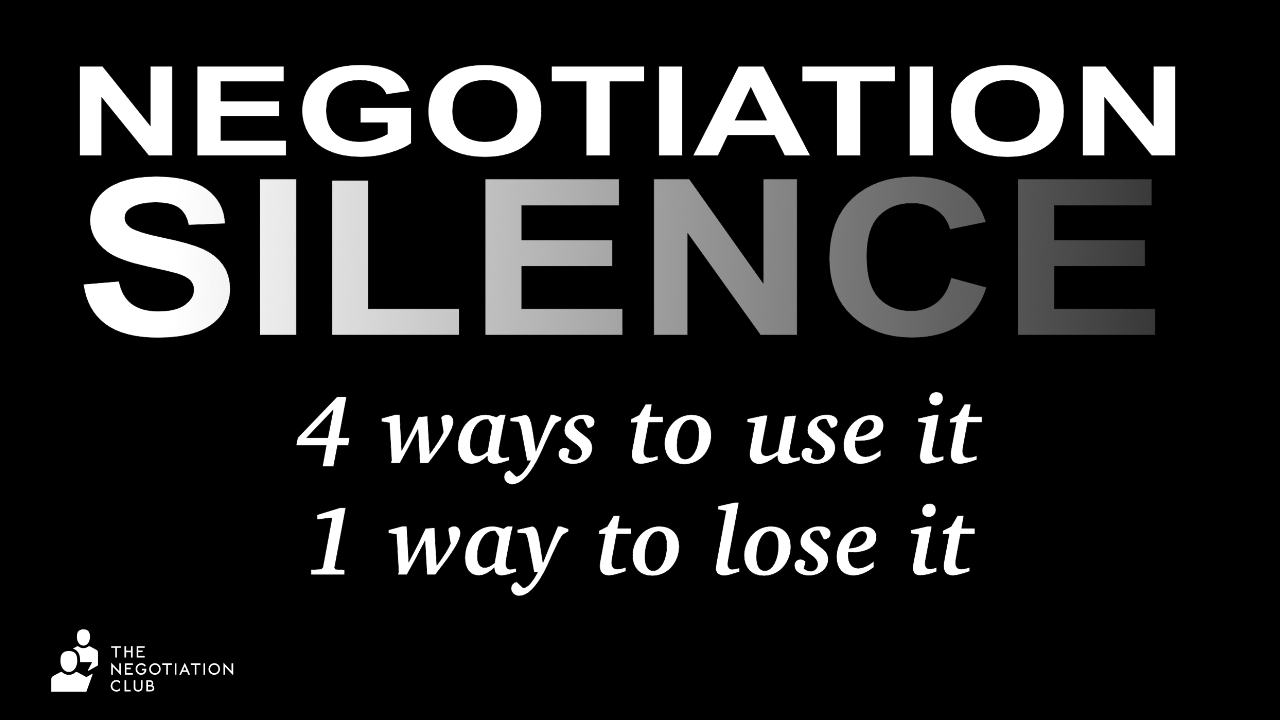The Power of Silence: 4 Ways to use Silence in Negotiation (and 1 to Avoid)
Apr 08, 2025
In negotiation, silence isn’t the absence of sound—it’s the presence of intent. It’s a tool, a tactic and sometimes... a trap. When used with purpose, silence can unlock critical insights, nudge the other party to reveal more, or simply give you the space to think. But it’s also easy to misuse.
At The Negotiation Club, we believe in one thing above all else: practice. And silence is one of those skills that needs to be deliberately practised to be effective. Here are four of the most powerful ways to use silence in a negotiation—and one specific scenario where silence could seriously backfire.
1. Use Silence Immediately After Asking a Question
You ask a question. Then—nothing!
No follow-up... No explanation... No justification... Just silence!
Why? Because adding more after your question weakens its power. You risk undermining it with bias, leading the other person, or diluting the clarity of what you’re really asking.
Let’s look at an example:
“What kind of flexibility do you have on delivery?”
... (pause)
“…because we’ve had issues in the past with timing and we really need this to hit a specific window.”
That second part nudges the other party towards a specific answer. You’ve now filled the space they could have used to genuinely respond. Instead, stay silent. Let your question stand on its own—and watch how the other party navigates that moment.
Practice Tip:
Run drills with a partner where you can only ask the question—and then you must remain completely silent until a response is given. You’ll be surprised how often your instinct is to fill the gap.
2. Use Silence Immediately After Making a Proposal
This is a classic. You’ve just made your proposal:
“We’re prepared to go ahead at £9,600 with delivery included.”
Now you wait... In silence!
Why? Because the proposal is your statement of position. If you start talking, you risk turning it into a pitch. You might even start negotiating against yourself without realising:
❌ “…but we could be a bit flexible depending on timing”
❌ “…unless that doesn’t work for you—we’re open to alternatives”
These additions weaken your position and make it seem as if you don’t believe in your own offer.
More importantly, silence gives you the chance to observe. The reaction to a proposal can reveal everything—facial expressions, body language, hesitation, quick acceptance, or signs of resistance.
Practice Tip:
After delivering your proposal, challenge yourself to count to five silently before saying anything further. Use that time to observe—not talk.
Try a FREE NEGOTIATION TASTER to practice your skills!
3. Use Silence After Receiving a Response
This one’s subtle—but powerful. Once you receive an answer to a question, resist the urge to immediately respond.
Instead, go silent. Here’s what happens:
- You get time to think - Their answer might need unpacking. What are they really saying? Are there hidden signals?
- They feel heard - Silence demonstrates that you’re processing—not just reacting. That builds rapport and shows active listening.
- They may keep talking - Humans dislike silence. If you pause long enough, they may add more detail, clarify their position, or even backtrack.
That silence encourages them to reflect and fill the gap—which can be pure gold in a negotiation.
Practice Tip:
Pair up and role-play receiving responses. Try holding silence for 3–5 seconds. Make notes during the pause. You’ll find the conversation becomes more reflective and less reactive.
4. Use Silence to Create Tension
Let’s be honest: silence can feel uncomfortable.
... And that’s why it works.
We’re socially conditioned to fill gaps in conversation. So when you deliberately stay silent—especially in a moment where the other party expects you to speak—it can create a subtle but effective pressure. That tension often prompts the other party to reveal more or respond differently than they would have if you’d jumped in.
For example:
Them: “This is the best we can offer.”
You: just look at them… and say nothing)
That simple pause can make them squirm. Often, they’ll continue:
“Well… maybe we could take another look at the pricing if…”
The key here is control. Don’t use silence to be manipulative or awkward for the sake of it. Use it to highlight the importance of a moment, to give space, or to encourage further discussion.
Practice Tip:
Run a mock negotiation where you consciously introduce silent pauses after key moments. See how often it leads to more information being shared.
WARNING: When NOT to Use Silence:
.... Avoid Silence After Receiving a Proposal You Plan to Reject!
This is where silence can betray you.
Imagine someone makes a proposal:
“We’re looking at £12,500, paid in 14 days.”
If your answer is no, say so—immediately. Silence in this moment sends the wrong signal. It suggests you’re considering the proposal, which gives the other party hope. Worse still, it gives them leverage.
Why? Because a fast, clear “no” adds credibility. If something is genuinely not acceptable, it should be easy to reject. A delayed response gives the impression that rejection was a choice, not a necessity—which can erode trust and invite pressure.
Practice Tip:
Train yourself to respond immediately with a clear rejection when appropriate. Try practising both verbal and non-verbal delivery (e.g., shaking your head and calmly saying, “No, I can’t accept that”) to make it feel natural and confident.
Final Thought ... Practising Silence Isn’t Passive
At The Negotiation Club, we train negotiators to be active—even in silence. Each moment of silence has a purpose. It’s not about disengaging. It’s about listening, observing, building rapport and maintaining control.
There are many different negotiation tactics and techniques but the next time you’re in a negotiation, don’t be afraid of silence. Use it deliberately. Practise it often. And learn when it’s your greatest strength—and when it’s your weakest move.
Try a FREE NEGOTIATION TASTER to practice your skills!


